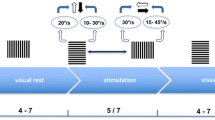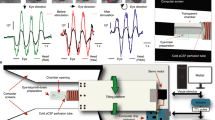Abstract
Animal experiments have demonstrated that the vast majority of vertical gaze-velocity Purkinje cells in the cerebellar floccular lobe, whose firing rate is modulated during vertical smooth pursuit eye movements, show a preference for downward pursuit. Here we validate the functional vertical asymmetry of the cerebellar flocculus in humans using functional magnetic resonance imaging by demonstrating a significantly higher activation of the floccular lobe for downward than for upward pursuit. The findings corroborate our recent hypothesis on the pathogenesis of cerebellar downbeat nystagmus.

Similar content being viewed by others
References
Krauzlis RJ (2004) Recasting the smooth pursuit eye movement system. J Neurophysiol 91:591–603
Stone LS, Lisberger SG (1990) Visual responses of Purkinje cells in the cerebellar flocculus during smooth-pursuit eye movements in monkeys. I. Simple spikes. J Neurophysiol 63:1241–1261
Krauzlis RJ, Lisberger SG (1996) Directional organization of eye movement and visual signals in the floccular lobe of the monkey cerebellum. Exp Brain Res 109:289–302
Stephan T, Kalla R, Marti S, Straumann D, Glasauer S. Asymmetric cerebellar flocculus activation for vertical smooth pursuit eye movements. Presented at the 11th Annual Meeting for Human Brain Mapping (HBM); June 12–16, 2005; Toronto, Ontario, Canada
Marti S, Bockisch CJ, Straumann D (2005) Prolonged asymmetric smooth pursuit stimulation leads to downbeat nystagmus in healthy human subjects. Invest Ophthalmol Vis Sci 46:143–149
Friston KJ, Ashburner J, Frith CD, Poline JP, Heather JD, Frackowiak RS (1995) Spatial registration and normalization of images. Hum Brain Mapp 2:165–189
Stephan T, Marx E, Brückmann H, Brandt T, Dieterich M (2002) Lid closure mimics head movement in fMRI. NeuroImage 16:1156–1158
Friston KJ, Holmes AP, Worsley KJ, Poline JP, Frith CD, Frackowiak RS (1995) Statistical parametric maps in functional imaging: a general linear approach. Hum Brain Mapp 2:189–210
Schmahmann JD, Doyon J, Toga AW, Petrides M, Evans AC (2000) MRI atlas of the human cerebellum. Academic, San Diego
Genovese CR, Lazar NA, Nichols T (2002) Thresholding of statistical maps in functional neuroimaging using the false discovery rate. Neuroimage 15:870–878
Schmid A, Rees G, Frith C, Barnes G (2001) An fMRI study of anticipation and learning of smooth pursuit eye movements in humans. NeuroReport 12:1409–1414
Lencer R, Nagel M, Sprenger A, Zapf S, Erdmann C, Heide W et al (2004) Cortical mechanisms of smooth pursuit eye movements with target blanking. An fMRI study. Eur J Neurosci 19:1430–1436
Noda H, Suzuki DA (1979) The role of the flocculus of the monkey in saccadic eye movements. J Physiol 294:317–334
Leigh RJ, Zee DS (2006) The neurology of eye movements, 4th edn. Oxford University Press, New York
Logothetis NK, Wandell BA (2004) Interpreting the BOLD signal. Annu Rev Physiol 66:735–769
Kim JS, Sharpe JA (2001) The vertical vestibulo-ocular reflex, and its interaction with vision during active head motion: effects of aging. J Vestib Res 11:3–12
Marti S, Straumann D, Glasauer S (2005) The origin of downbeat nystagmus: an asymmetry in the distribution of on-directions of vertical gaze-velocity Purkinje cells. Ann N Y Acad Sci 1039:548–553
Marti S, Straumann D, Büttner U, Glasauer S (2008) A model-based theory on the origin of downbeat nystagmus. Exp Brain Res 188:613–631
Pierrot-Deseilligny C, Milea D (2005) Vertical nystagmus: clinical facts and hypotheses. Brain 128:1237–1246
Wagner JN, Glaser M, Brandt T, Strupp M (2008) Downbeat nystagmus: aetiology and comorbidity in 117 patients. J Neurol Neurosurg Psychiatry 79:672–677
Halmagyi GM, Rudge P, Gresty MA, Sanders MD (1983) Downbeating nystagmus. A review of 62 cases. Arch Neurol 40:777–784
Glasauer S, Hoshi M, Büttner U (2005) Smooth pursuit in patients with downbeat nystagmus. Ann N Y Acad Sci 1039:532–535
Kalla R, Deutschlander A, Hüfner K, Stephan T, Jahn K, Glasauer S et al (2006) Detection of floccular hypometabolism in downbeat nystagmus by fMRI. Neurology 66:281–283
Acknowledgments
We are grateful to K. Ogston for critically reading the manuscript. This work was supported by the Deutsche Forschungsgemeinschaft (Gl 342/1-3; BR 639/6-3), Swiss National Science Foundation (31-63465.00/#3200BO-1054534), and Betty and David Koetser Foundation for Brain Research.
Conflicts of interest
The authors have no conflicts of interest.
Author information
Authors and Affiliations
Corresponding author
Rights and permissions
About this article
Cite this article
Glasauer, S., Stephan, T., Kalla, R. et al. Up–Down Asymmetry of Cerebellar Activation During Vertical Pursuit Eye Movements. Cerebellum 8, 385–388 (2009). https://doi.org/10.1007/s12311-009-0109-5
Received:
Accepted:
Published:
Issue Date:
DOI: https://doi.org/10.1007/s12311-009-0109-5




